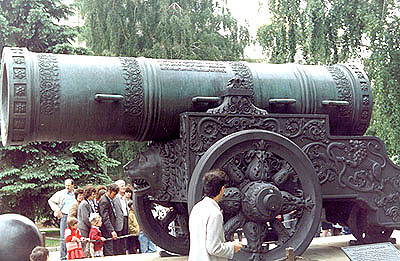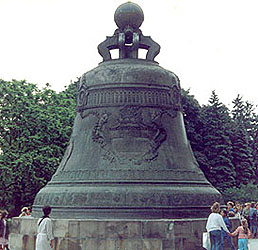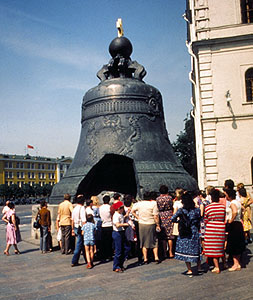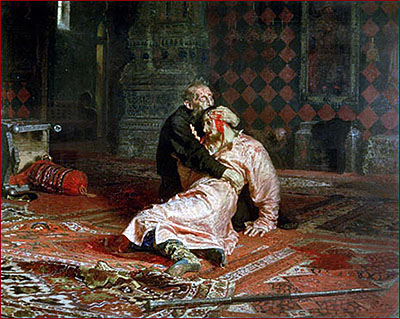Painting of Tsar Ivan IV the Terrible (1897, oil on canvas; Tretiakov Museum) by Viktor Vasnetsov (1848—1926), one of
my favorite Russian artists. Vasnetsov experimented with many different art genres
during his long career, including some church architecture and work on theatrical scenery. He
may today best be remembered for his work on legendary and historical subjects from
Russia's past; subjects which
he carefully researched before beginning his work. |
 |
It is customary when speaking about the reign of Ivan IV (1530-1584) the Terrible, to speak in terms of "good Ivan, bad Ivan," or the first, good half of his reign; then the bad, terrible, second half of his reign. But I am not sure what good, if any, was accomplished for Russia during the reign of Ivan IV. I think that what he really succeeded in doing was setting the stage for the ensuing Time of Troubles, an era marked by a complete breakdown of the country's social and national fabric. He clearly was one of the most ruthless tyrants known to history.
Some
things to remember when we study Ivan IV. First, we
simply do not know a lot of specifics about his childhood other than
the
fact that his dad died when
Ivan was two and that his mother was poisoned when he was seven.
This brought him under the control of the Shuiskii family. Check
this out: "The ruthless
Shuiskys gradually gained more power. In 1539 the Shuiskys led a raid on the
palace, rounding up a number of Ivan's remaining confidants. They had the loyal Fyodor
Mishurin skinned alive and left on public view in a Moscow square. On December 29, 1543,
13-year-old Ivan suddenly ordered the arrest of Prince Andrew Shuisky, who was reputed to
be a cruel and corrupt person. He was thrown into an enclosure with a pack of starved
hunting dogs. The rule of the boyars had ended." (These were certainly cruel times
in Russia, and it was not about to get much better.)
There were some other "turning points" in Ivan's life. In 1553, Ivan was very sick and thought that he was about to die. He asked the boyars and nobles to swear an oath of loyalty to his infant son Dmitrii, which many of them refused to do. Ivan recovered and survived; many of those princes did not (neither did the infant Dmitrii). In 1560 his first wife Anastasia died; the two had been happily married for thirteen years. Ivan was inconsolable, and he was convinced that she was poisoned. (Note that "Recent forensic tests on Anastasia's remains have revealed more than ten times the normal levels of mercury in her hair. It is likely, that Anastasia was indeed murdered."(www.bbc.co.uk/history/programmes/ivan/ivanmain.shtml) Finally, in 1581 a disagreement with his son ended tragically when the tsar struck his son and killed him (not good).
So, you might ask, where did the tsar turn for relief? Well, after his first wife died he married an additional seven times, and this does not include all of his mistresses (most of these women did not survive very long). Ivan also became addicted to the ingestion of mercury, which he kept bubbling in small pots in his room for his consumption--Now, that surely could not have been a good idea. A later exhumation of his body showed that he suffered from mercury poisoning.
Ok, I tried to make note of some "good things" about his reign, although you can easily make a reverse case for any of these:
- the "conquest" of Siberia by the Cossack Ermak Timofeevich (d. 1585)
- the capture of Kazan (1552) and Astrakhan (1554)
- first to title himself as tsar when he was crowned in 1547 at age sixteen
- his revision of the Russian law code
- the creation of a standing army armed with muskets, "the streltsy"
- the use of a council of nobles for "advice"
- the subordination of the orthodox church to the state
- the opening of the port of Arkhangelsk on the White Sea for trade with Western Europe
- the conquest of the Baltic cities Narva and Polotsk, which also allowed trade to Europe
I made a note of some bad things:
- the Livonian war (1558-1583), which involved Russia in almost continuous war with Sweden, Denmark and Poland-Lithuania for over twenty years. This proved to be an enormous drain on Russian resources--with no clear benefits--that led to the fixing of serfdom as a Russian institution.
- the oprichnina (1565)
- the terror and the unbelievably cruel tortures (Isabel De Madariaga's new book, Ivan the Terrible (2005) is just unbelievably depressing to read, page after page, account after account ,of slaughters, tortures, poisonings, intrigues, executions, etc. (No wonder that Stalin so revered Ivan IV.)
- the destruction of the princely and boyar class, although you could put this into either category depending on your view
- the murder of his son (see below)
 |
The Tsar Pushka (1586) is a huge cannon, forged by Andrei Chokhov, weighing about 40 tons (about 17 ft. long). The cannon was intended to be used to defend the Kremlin in times of war by firing grapeshot, but it has never been used. I always associated the cannon with Ivan--even though it was forged after his death on the order of Tsar Theodore I, Ivan's son--because of the grandiose nature of the gun, a perfect expression of the grandiose nature of Ivan's reign. The "weapon," listed in the Guinness Book of World Records, is in the Kremlin next to the Tsar Kolokol (see below). I am not sure if anyone has ever tried to see if it really works. |
 |

|
The Tsar Kolokol is near the Tsar Pushka. Again, even though the bell dates to much after the reign of Ivan IV, I always associated the bell, as with the cannon, with Ivan. The Bell, weighing an estimated 222 tons (height 6.14 m, diameter 6.6 m) was cast in bronze by Ivan Motorin and his son Mikhail in 1733–1735 on the commission of Empress Anna I. Understandably, the bell was never rung--How on earth were they intending to hang it anywhere to ring it. Then during a fire at the Kremlin in 1737, a huge slab (11.5 tons) broke off the bell due to uneven heating while it was still in the casting pit. The Bell was not actually raised from its casting pit until almost a hundred years later. |
|
 |
|
OK, so this was the bad part of Ivan's reign. Ilya Efimovich Repin (1844-1930), although he rarely painted historical subjects, turned to Ivan IV for this masterpiece, Ivan the Terrible and His Son Ivan: November 16, 1581 (1885, Oil on canvas, 199.5 x 254 cm., Tretiakov Gallery, Moscow). Repin, who was one of the leaders of the Peredvizhniki artistic school, had begun to think about this subject after the assassination of Alexander II in 1881. Tsar Ivan and son had a not-so-good relationship, and during one of their disputes over the treatment of the son's wife (Ivan had challenged her dress and beat her so badly that she suffered a miscarriage), Ivan struck his son with his staff on the head; the son died a few days later. The murder of son by father (repeated during the reign of Peter the Great) proved not a good omen for the remainder of Ivan's reign. Repin captured the unbelievable anguish in his work and the tragedy of Russian history. |
|
- W. Bruce Lincoln, The Conquest of a Continent: Siberia and the Russians (1994)
- The Domostroi: Rules for Households in the Time of Ivan the Terrible, translated by Carolyn Pouncy (1994)
- Sergei Platonov, Ivan the Terrible (1924), Boris Godunov (1921) or The Time of Troubles (1924)
- Ruslan Skrynnikov, Ivan the Terrible (1975) or Boris Godunov (1978)
- Some lectures by the late Professor Michael Boro Petrovich are available on the web: Ivan the Terrible, Boris Godunov, Tsar Boris, The False Dmitrii, the Time of Troubles and the Rise of the Romanovs.
- On the Kremlin, see The Moscow Kremlin and The Moscow Kremlin: An Historic Tour.
- The Moscow Patriarchate (Official page)
- Russia Engages the World, 1453-1825, created by the New York Public Library, has a good overview about the reign of Ivan IV.
- There is a bit of material on Ivan the Terrible on the web, see, for example, www.xs4all.nl/~kvenjb/madrus.htm#grosny.
- The Xenophile historian has some remarks about Ivan the Terrible and The Time of Troubles
- Meeting of Frontiers examines the American settlement of the West, the Russian settlement of Siberia and the Russian Far East, and the Russian-American frontier in Alaska and the Pacific Northwest.